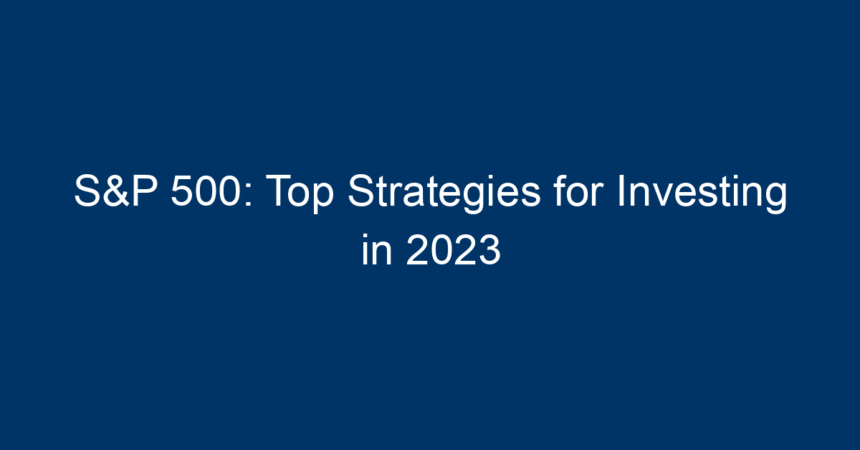Investing in the S&P 500 has long been a cornerstone of wealth-building strategies for both seasoned traders and novice investors alike. As we step into 2023, the landscape of investing continues to evolve, offering fresh opportunities alongside new challenges. In this article, we’ll delve into the top strategies for investing in the S&P 500 that can help you navigate this dynamic market and potentially enhance your investment returns.
Understanding the S&P 500
The S&P 500, or Standard & Poor’s 500, is a stock market index that tracks the performance of 500 of the largest publicly traded companies in the United States. Its composition includes a diverse range of sectors—from technology and healthcare to consumer goods and energy—making it a barometer of the overall U.S. economy. For many investors, the S&P 500 serves as an essential benchmark for assessing the performance of their investments.
Why Invest in the S&P 500?
Investing in the S&P 500 offers several advantages:
- Diversification: With 500 companies across various sectors, the index helps mitigate risk.
- Historical Performance: Historically, the S&P 500 has provided solid returns, averaging around 10% annually over the long term.
- Economic Indicators: The index reflects the economic health of the U.S., offering insights into potential market movements.
Top Strategies for Investing in the S&P 500 in 2023
1. Dollar-Cost Averaging (DCA)
Dollar-cost averaging is a strategy where you invest a fixed amount of money into an investment at regular intervals, regardless of the asset’s price. This approach can smooth out the effects of market volatility and reduce your overall cost per share.
How to Implement DCA:
- Set a Budget: Determine how much you can invest on a regular basis, whether it’s monthly or quarterly.
- Choose the Right Time: Pick a specific day each month to make your investment.
- Stay Consistent: Stick to your plan even during market downturns.
2. Focus on Growth Sectors
With the rapid evolution of technology and changing consumer behaviors, certain sectors within the S&P 500 are poised for growth in 2023. Consider focusing on sectors such as technology, healthcare, and renewable energy.
Key Growth Areas in 2023:
- Technology: Companies in cloud computing, artificial intelligence, and cybersecurity continue to show promising growth prospects.
- Healthcare: Innovations in biotech and telehealth are transforming the sector, making it a worthwhile focus.
- Renewable Energy: With climate change driving policy changes, investments in clean energy companies could deliver significant returns.
3. Rebalance Your Portfolio
Regularly rebalancing your portfolio ensures that you maintain your desired level of risk and stay aligned with your investment goals. As some sectors within the S&P 500 may outperform others, you may find that your portfolio gets out of balance.
Steps to Rebalance:
- Review Your Asset Allocation: Assess your current holdings and compare them against your target allocation.
- Sell Overperforming Assets: Consider selling a portion of your investments in sectors that have grown significantly.
- Reinvest in Underperformers: Use the proceeds from overperforming sectors to buy into underperforming ones, taking advantage of potential upside.
4. Keep an Eye on Economic Indicators
Understanding economic indicators can provide insights into potential market movements. Key indicators include interest rates, inflation rates, and unemployment rates.
Important Economic Indicators to Monitor:
- Federal Reserve Policies: Changes in interest rates can significantly impact market performance.
- Inflation Rates: Higher inflation can erode purchasing power, affecting consumer spending and corporate earnings.
- Consumer Confidence: High consumer confidence can lead to increased spending, positively impacting corporate profits.
5. Utilize Exchange-Traded Funds (ETFs)
ETFs that track the S&P 500 can be an excellent way to gain exposure to the index. These investment vehicles offer diversification and can often be bought and sold like stocks.
Benefits of Using ETFs:
- Low Expense Ratios: Many S&P 500 ETFs have lower management fees than mutual funds.
- Flexibility: You can buy and sell shares throughout the trading day.
- Automatic Diversification: You gain exposure to 500 companies with a single investment.
6. Invest for the Long Term
While market fluctuations can tempt you to react impulsively, one of the best strategies for investing in the S&P 500 is to maintain a long-term perspective. The index has shown resilience, recovering from downturns over time.
Tips for Long-Term Investing:
- Stay the Course: Resist the urge to sell during market corrections.
- Focus on Fundamentals: Pay attention to the underlying performance of companies within the index.
- Review Your Strategy Annually: Make adjustments to your strategy as needed, but remain committed to long-term goals.
Conclusion: Actionable Insights for 2023
Investing in the S&P 500 in 2023 presents a myriad of opportunities. By employing strategies such as dollar-cost averaging, focusing on growth sectors, regularly rebalancing your portfolio, monitoring economic indicators, utilizing ETFs, and committing to long-term investing, you can enhance your chances of success.
As you navigate the complexities of the market, remember that patience and discipline often yield the best results. This year, set clear investment goals and stay informed on market trends to make the most of your S&P 500 investments. By doing so, you’ll be well-equipped to harness the potential of this powerful index and secure your financial future.




